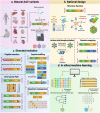Adeno-associated virus as a delivery vector for gene therapy of human diseases
- PMID: 38565561
- PMCID: PMC10987683
- DOI: 10.1038/s41392-024-01780-w
Adeno-associated virus as a delivery vector for gene therapy of human diseases
Abstract
Adeno-associated virus (AAV) has emerged as a pivotal delivery tool in clinical gene therapy owing to its minimal pathogenicity and ability to establish long-term gene expression in different tissues. Recombinant AAV (rAAV) has been engineered for enhanced specificity and developed as a tool for treating various diseases. However, as rAAV is being more widely used as a therapy, the increased demand has created challenges for the existing manufacturing methods. Seven rAAV-based gene therapy products have received regulatory approval, but there continue to be concerns about safely using high-dose viral therapies in humans, including immune responses and adverse effects such as genotoxicity, hepatotoxicity, thrombotic microangiopathy, and neurotoxicity. In this review, we explore AAV biology with an emphasis on current vector engineering strategies and manufacturing technologies. We discuss how rAAVs are being employed in ongoing clinical trials for ocular, neurological, metabolic, hematological, neuromuscular, and cardiovascular diseases as well as cancers. We outline immune responses triggered by rAAV, address associated side effects, and discuss strategies to mitigate these reactions. We hope that discussing recent advancements and current challenges in the field will be a helpful guide for researchers and clinicians navigating the ever-evolving landscape of rAAV-based gene therapy.
© 2024. The Author(s).
Conflict of interest statement
G.G. is a scientific co-founder of Voyager Therapeutics, Adrenas Therapeutics, and Aspa Therapeutics, and holds equity in these companies. G.G. is an inventor on patents with potential royalties licensed to Voyager Therapeutics, Aspa Therapeutics, and other biopharmaceutical companies. D.J. G. is a cofounder of Aspa Therapeutics and holds equity in the company. D.J.G. is an inventor of patents with potential royalties licensed to Aspa Therapeutics and other biopharmaceutical companies. The remaining authors declare no competing interests. G.G. is one of the Associate Editors of
Figures






Similar articles
-
The Black Book of Psychotropic Dosing and Monitoring.Psychopharmacol Bull. 2024 Jul 8;54(3):8-59. Psychopharmacol Bull. 2024. PMID: 38993656 Free PMC article. Review.
-
Limb Perfusion Delivery of a rAAV1 Alpha-1 Antitrypsin Vector in Non-Human Primates Is Safe but Insufficient for Therapy.Genes (Basel). 2024 Sep 10;15(9):1188. doi: 10.3390/genes15091188. Genes (Basel). 2024. PMID: 39336779 Free PMC article.
-
A rapid and systematic review of the clinical effectiveness and cost-effectiveness of paclitaxel, docetaxel, gemcitabine and vinorelbine in non-small-cell lung cancer.Health Technol Assess. 2001;5(32):1-195. doi: 10.3310/hta5320. Health Technol Assess. 2001. PMID: 12065068
-
Management of urinary stones by experts in stone disease (ESD 2025).Arch Ital Urol Androl. 2025 Jun 30;97(2):14085. doi: 10.4081/aiua.2025.14085. Epub 2025 Jun 30. Arch Ital Urol Androl. 2025. PMID: 40583613 Review.
-
The Lived Experience of Autistic Adults in Employment: A Systematic Search and Synthesis.Autism Adulthood. 2024 Dec 2;6(4):495-509. doi: 10.1089/aut.2022.0114. eCollection 2024 Dec. Autism Adulthood. 2024. PMID: 40018061 Review.
Cited by
-
Gene Therapy for Parkinson's Disease Using Midbrain Developmental Genes to Regulate Dopaminergic Neuronal Maintenance.Int J Mol Sci. 2024 Nov 18;25(22):12369. doi: 10.3390/ijms252212369. Int J Mol Sci. 2024. PMID: 39596436 Free PMC article. Review.
-
Transcriptomics-informed pharmacology identifies epigenetic and cell cycle regulators that enhance AAV production.Mol Ther Methods Clin Dev. 2024 Nov 18;32(4):101384. doi: 10.1016/j.omtm.2024.101384. eCollection 2024 Dec 12. Mol Ther Methods Clin Dev. 2024. PMID: 39687728 Free PMC article.
-
Revolutionizing Neuroimmunology: Unraveling Immune Dynamics and Therapeutic Innovations in CNS Disorders.Int J Mol Sci. 2024 Dec 19;25(24):13614. doi: 10.3390/ijms252413614. Int J Mol Sci. 2024. PMID: 39769374 Free PMC article. Review.
-
Gene Therapy: Towards a New Era of Medicine.AAPS PharmSciTech. 2024 Dec 19;26(1):17. doi: 10.1208/s12249-024-03010-6. AAPS PharmSciTech. 2024. PMID: 39702810 Review.
-
Structural studies of Parvoviridae capsid assembly and evolution: implications for novel AAV vector design.Front Artif Intell. 2025 Apr 2;8:1559461. doi: 10.3389/frai.2025.1559461. eCollection 2025. Front Artif Intell. 2025. PMID: 40242328 Free PMC article. Review.
References
Publication types
MeSH terms
Grants and funding
LinkOut - more resources
Full Text Sources
Other Literature Sources

